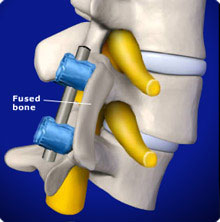Additional Resources
- NOTE: This list provides links to external on-line resources. Each link will open a new browser window.
- North American Spine Society a non-profit corporation
- Cervical Spine Research Society
- Scoliosis Research Society
- The International Spine Intervention Society
- American Academy of Pain Medicine
- American Pain Society
- A-O North America
- American Academy of Physical Medicine and Rehabilitation
- American Academy of Orthopaedic Surgeons
- American Association of Neurological Surgeons
- Back.com
- Neck Reference
- iScoliosis


- Notice of Disclaimer for external resource links.
The Spine Institute does not support nor endorse any of the resources listed above. They are provided for informational purposes only, and is not a comprehensive list.
Introduction to Spinal Fusion
Abnormalities or degeneration ("wearing") of the discs between vertebrae may lead to abnormal motions causing back and or leg pain. If this pain continues following attempts at rehabilitation, surgery may be recommended. Surgical treatments for this pain commonly involve eliminating motion between affected vertebrae by initiating new bone growth, ultimately joining the two vertebrae together. The surgical procedure is generally referred to as a 'spinal fusion procedure'.Procedure
 Generally the procedure is completed to induce new bone growth into
the space between the transverse processes (posterolateral fusion)
or the vertebral bodies (anterior interbody fusion). The spinal column
may be surgically approached via an incision from the back or through
the abdomen. A fusion may be attempted either on the front or back
side of the spine.
Generally the procedure is completed to induce new bone growth into
the space between the transverse processes (posterolateral fusion)
or the vertebral bodies (anterior interbody fusion). The spinal column
may be surgically approached via an incision from the back or through
the abdomen. A fusion may be attempted either on the front or back
side of the spine.There are different types of spinal fusion.
Anterior Interbody Spinal Fusion This procedure is performed via an incision in a patient's abdomen. The vertebral bodies are approached from the front and a femoral ring (cadaver bone), or cylindrical cage is placed between the two vertebral bodies. The femoral ring or cage instrumentation is filled with bone graft usually obtained from the patient's hip (iliac crest). If fusion is successful, motion between the vertebrae will stop and any pain caused by abnormal motion between those vertebrae will no longer exist.
Posterior Spinal Fusion, sometimes referred to as a posterolateral spinal fusion, is performed from an incision made in the back. The procedure entails roughening the surfaces of the transverse processes and inserting bone graft between the transverse processes. The bone is usually obtained from a patient's hip (iliac crest). If fusion is successful, motion between the vertebrae will stop and any pain caused by abnormal motion between those vertebrae will no longer exist.
Because of the limited supply of a patient's own bone and possible donor site pain or morbidity, there is a continuing search for ideal bone graft substitute.
Latest news
Visit our media library for access to all of our news videos.
The Spine Institute is often in the news pioneering new treatments to help the reported 34 million Americans 18 years and older who suffer lower back pain, and another 9 million who suffer neck pain. Watch the news coverage here.
